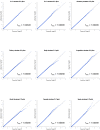HLA-DRB1*11 and variants of the MHC class II locus are strong risk factors for systemic juvenile idiopathic arthritis
- PMID: 26598658
- PMCID: PMC4702958
- DOI: 10.1073/pnas.1520779112
HLA-DRB1*11 and variants of the MHC class II locus are strong risk factors for systemic juvenile idiopathic arthritis
Abstract
Systemic juvenile idiopathic arthritis (sJIA) is an often severe, potentially life-threatening childhood inflammatory disease, the pathophysiology of which is poorly understood. To determine whether genetic variation within the MHC locus on chromosome 6 influences sJIA susceptibility, we performed an association study of 982 children with sJIA and 8,010 healthy control subjects from nine countries. Using meta-analysis of directly observed and imputed SNP genotypes and imputed classic HLA types, we identified the MHC locus as a bona fide susceptibility locus with effects on sJIA risk that transcended geographically defined strata. The strongest sJIA-associated SNP, rs151043342 [P = 2.8 × 10(-17), odds ratio (OR) 2.6 (2.1, 3.3)], was part of a cluster of 482 sJIA-associated SNPs that spanned a 400-kb region and included the class II HLA region. Conditional analysis controlling for the effect of rs151043342 found that rs12722051 independently influenced sJIA risk [P = 1.0 × 10(-5), OR 0.7 (0.6, 0.8)]. Meta-analysis of imputed classic HLA-type associations in six study populations of Western European ancestry revealed that HLA-DRB1*11 and its defining amino acid residue, glutamate 58, were strongly associated with sJIA [P = 2.7 × 10(-16), OR 2.3 (1.9, 2.8)], as was the HLA-DRB1*11-HLA-DQA1*05-HLA-DQB1*03 haplotype [6.4 × 10(-17), OR 2.3 (1.9, 2.9)]. By examining the MHC locus in the largest collection of sJIA patients assembled to date, this study solidifies the relationship between the class II HLA region and sJIA, implicating adaptive immune molecules in the pathogenesis of sJIA.
Keywords: Still’s disease; autoinflammation; human leukocyte antigen; systemic juvenile idiopathic arthritis.
Conflict of interest statement
The authors declare no conflict of interest.
Figures







Comment in
-
Autoinflammation and autoimmunity in systemic juvenile idiopathic arthritis.Proc Natl Acad Sci U S A. 2015 Dec 29;112(52):15785-6. doi: 10.1073/pnas.1521837113. Epub 2015 Dec 17. Proc Natl Acad Sci U S A. 2015. PMID: 26677874 Free PMC article. No abstract available.
References
-
- Petty RE, et al. International League of Associations for Rheumatology International League of Associations for Rheumatology classification of juvenile idiopathic arthritis: Second revision, Edmonton, 2001. J Rheumatol. 2004;31(2):390–392. - PubMed
-
- Woo P. Systemic juvenile idiopathic arthritis: Diagnosis, management, and outcome. Nat Clin Pract Rheumatol. 2006;2(1):28–34. - PubMed
-
- Martini A. Systemic juvenile idiopathic arthritis. Autoimmun Rev. 2012;12(1):56–59. - PubMed
-
- Behrens EM, Beukelman T, Paessler M, Cron RQ. Occult macrophage activation syndrome in patients with systemic juvenile idiopathic arthritis. J Rheumatol. 2007;34(5):1133–1138. - PubMed
Publication types
MeSH terms
Substances
Grants and funding
- N1R01-AR062886/AR/NIAMS NIH HHS/United States
- 20542/ARC_/Arthritis Research UK/United Kingdom
- RC1 AR058587/AR/NIAMS NIH HHS/United States
- R01 AR060893/AR/NIAMS NIH HHS/United States
- R01-DK076025/DK/NIDDK NIH HHS/United States
- R01 AR059049/AR/NIAMS NIH HHS/United States
- AG041718/AG/NIA NIH HHS/United States
- 098051/WT_/Wellcome Trust/United Kingdom
- AG030653/AG/NIA NIH HHS/United States
- T32 AR050942/AR/NIAMS NIH HHS/United States
- R01 DK076025/DK/NIDDK NIH HHS/United States
- R01 AR062886/AR/NIAMS NIH HHS/United States
- R01 AG030653/AG/NIA NIH HHS/United States
- 085475/WT_/Wellcome Trust/United Kingdom
- R01 AG041718/AG/NIA NIH HHS/United States
- AG005133/AG/NIA NIH HHS/United States
- 20386/ARC_/Arthritis Research UK/United Kingdom
- U01 DK062420/DK/NIDDK NIH HHS/United States
- ZIA AR041198/ImNIH/Intramural NIH HHS/United States
- Z01-HG200370/HG/NHGRI NIH HHS/United States
- 20542/VAC_/Versus Arthritis/United Kingdom
- Z01-AR041198/AR/NIAMS NIH HHS/United States
- R01-AR059049/AR/NIAMS NIH HHS/United States
- 20385/ARC_/Arthritis Research UK/United Kingdom
- 076113/WT_/Wellcome Trust/United Kingdom
- Z99 AR999999/ImNIH/Intramural NIH HHS/United States
- 20386/VAC_/Versus Arthritis/United Kingdom
- UL1 TR001073/TR/NCATS NIH HHS/United States
- P50 AG005133/AG/NIA NIH HHS/United States
- R01-AR060893/AR/NIAMS NIH HHS/United States
- UL1 TR001425/TR/NCATS NIH HHS/United States
- UH2 AR067677/AR/NIAMS NIH HHS/United States
- U01-DK062420/DK/NIDDK NIH HHS/United States
- P30 AR047363/AR/NIAMS NIH HHS/United States
- MR/M004600/1/MRC_/Medical Research Council/United Kingdom
LinkOut - more resources
Full Text Sources
Other Literature Sources
Medical
Research Materials

